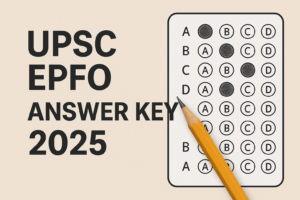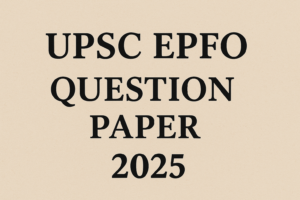Q No. 2- Comment on the need of administrative tribunals as compared to the court system. Assess the impact of the recent tribunals reforms through rationalisation of tribunals made in 2021. (10 marks, 150 Words)
| Approach: Start with the background and constitutional basis of administrative tribunals with a judicial quote. Compare their need vis-à-vis regular courts using data/examples. Then assess the Tribunals Reforms Act, 2021, highlighting both positive and negative impacts. Conclude with a balanced view and reform suggestions like strengthening independence. |
Model Answer
Administrative tribunals were introduced through the 42nd Amendment, 1976 under Articles 323-A to ensure specialised and speedy justice in select fields. As the Supreme Court observed in “Tribunals have become the common man’s route to speedy justice.
Need of administrative tribunals as compared to the court system:
| Court System – Challenges | Why Administrative Tribunals are Needed | Examples |
| Huge Pendency & Delay: Courts, especially High Courts, face a backlog of 4.73 crore cases, causing delays.
As of July 2025, there were 5.29 crore pending cases: 4.65 crore in district/subordinate courts, 63 lakh in High Courts, and ~86,700 in the Supreme Court |
Speedy Disposal: Tribunals ensure quicker resolution with simplified procedures. | CAT (1985) reduces service matter burden, resolving 90% cases efficiently (CAT Report, 2023). |
| Lack of Technical Expertise: Judges, as generalists, lack training in fields like environment or telecom. | Specialized Knowledge: Tribunals include technical and judicial members for domain expertise. | |
| Expensive Litigation: Formal court procedures and senior advocates make justice costly. | Cost-Effective & Accessible: Simplified processes and less formal representation reduce costs. | |
| Overburdened Higher Judiciary: Service, tax, and company law cases crowd High Courts and Supreme Court. | Reduces Burden: Tribunals handle routine, specialized disputes, freeing higher courts. | S.P. Sampath Kumar v. Union of India (1987) upheld CAT’s role as a substitute in service matters. |
| Rigid Procedures: Courts are bound by Civil Procedure Code (CPC) and Evidence Act, causing delays. | Flexible Procedures: Tribunals follow natural justice, not strict CPC/Evidence rules. | |
| Lack of Uniformity in Sectoral Rulings: Courts may not ensure consistent sector-specific jurisprudence. | Sectoral Consistency: Tribunals develop consistent case law in niche domains. |
However, tribunals suffer from executive control (ministries oversee bodies against whom disputes arise, as flagged in Madras Bar Association v. Union of India, 2010), fragmented administration with no single nodal agency, and poor infrastructure and staffing.
Impact of the recent tribunals reforms through rationalisation of tribunals made in 2021:
Changes Introduced by the Tribunals Reforms Act, 2021
- Abolition of appellate bodies: The Act eliminates certain appellate tribunals, transferring their roles to existing judicial bodies like High Courts or civil courts.
- Centralized rule-making authority: The Central Government is authorized to set rules for tribunal members’ qualifications, appointments, tenure, salaries, allowances, resignation, removal, and other service conditions, removing these provisions from the Finance Act, 2017.
- Appointment process: Tribunal Chairpersons and Members are appointed by the Central Government based on recommendations from a Search-cum-Selection Committee.
- State Tribunal Committees: Separate search committees are established for state-level tribunals.
- Decision Timeline: The Central Government is expected to act on the committee’s recommendations, preferably within three months.
- Tenure and Age Limits: Chairpersons serve a four-year term or until age 70, whichever comes first; other members serve a four-year term or until age 67, whichever is earlier, with a minimum appointment age of 50 years.
Positive impact of the changes
- Rationalisation of system: Reduced number of tribunals from 26 to 19, eliminating duplication.
- E.g.: Appellate authority for film certification shifted from Film Appellate Tribunal to High Courts, saving administrative costs.
- Judicial consistency: By transferring some matters back to High Courts (e.g., airport tariff disputes, copyright appeals), uniformity of judicial pronouncements is ensured.
- Administrative efficiency: Multiple small tribunals with low case load were merged, improving resource utilisation.
- Brings clarity to litigants on forum availability.
- Streamlining appointments: Created uniform rules for appointments and service conditions, ending wide variation across tribunals.
Negative impact of the changes
- Overburdening high courts: Transfer of cases (like consumer appeals, copyright, film certification) to High Courts risks further clogging them. With 63 lakh cases already pending in HCs (2025), this may defeat the very purpose of tribunals.
- Threat to judicial independence: Short tenure of 4 years for tribunal members discourages experienced professionals and compromises continuity.
- E.g.: The executive-dominated selection committee has been criticised; SC in Madras Bar Association (2021) held some provisions unconstitutional.
- Accessibility concerns: High Courts are not present in every district, unlike some tribunals that had benches in smaller towns.
- Loss of technical expertise: Merging technical tribunals with generalist courts dilutes domain knowledge.
- E.g.: Copyright Appellate Tribunal had subject experts, whereas High Courts may lack such specialization.
Way forward
- Centralized oversight mechanism: Establish a dedicated body for tribunal monitoring, as recommended by CII (May 2025), to ensure efficiency and independence.
- Implement Law Commission recommendations: Adopt 272nd Law Commission Report (2017) suggestions on uniform qualifications and tenure extensions for stability.
- Judicial Safeguards: Strengthen via SC guidelines, like in Madras Bar Association (2021), and incorporate ICJ report insights on judicial independence (Jan 2025).
- Digitization and Capacity Building: Mandate AI integration and training, per ongoing pilots and PRS analyses for reducing pendency.
Therefore, as the Supreme Court observed in L. Chandra Kumar (1997), tribunals are now “an indispensable part of the justice system”, strengthening them with reforms like a National Tribunals Commission can truly balance efficiency with fairness.

 UPSC EPFO Cut Off 2025 (Expected): Categ...
UPSC EPFO Cut Off 2025 (Expected): Categ...
 UPSC EPFO Answer Key 2025 Out (Unofficia...
UPSC EPFO Answer Key 2025 Out (Unofficia...
 UPSC EPFO Question Paper 2025 PDF Downlo...
UPSC EPFO Question Paper 2025 PDF Downlo...

























